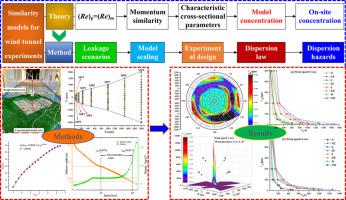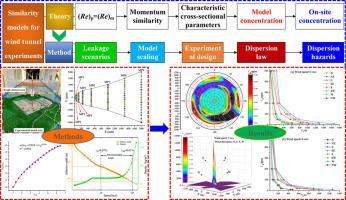Preventing sour gas hazards: terrain-aware buffer zoning via wind tunnel modeling
IF 10
1区 环境科学与生态学
Q1 ENGINEERING, ENVIRONMENTAL
引用次数: 0
Abstract
Mitigating hydrogen sulfide dispersion from sour gas facilities is critical for achieving cleaner production in the energy sector. The high-pressure nature of these releases leads to highly complex dispersion processes. This study develops a novel wind tunnel experimental similarity model to accurately predict high-pressure gas dispersion. This method integrates jet dynamics and atmospheric boundary layer theory, significantly reducing costs compared to full-scale trials. The model was applied to investigate H2S dispersion under two wind speeds and eight wind directions. Results show that the critical concentration (100 ppm) dispersion distances range from 136– 570 m (at 2 m/s) to 81–313 m (at 4 m/s), with a 3.9–4.2-fold variation across wind directions. Maximum concentrations differed by up to 9.1 times at 2 m/s and 4.8 times at 4 m/s. This variation occurred among different wind directions. This framework supports cleaner production and enables dynamic safety zoning. Compared to conventional fixed buffer zones, land occupancy in mountainous regions can be reduced by up to 88.4 % or increased by 16.6 %. This terrain-aware approach precisely identifies risks, prevents cascade failures, facilitates ISO 14001 certification, and provides a resource-efficient basis for balancing industrial safety with environmental protection.


防止酸性气体危害:通过风洞建模进行地形感知缓冲区划分
减少含硫气体设施的硫化氢分散对于实现能源部门的清洁生产至关重要。这些释放的高压性质导致了高度复杂的分散过程。本文建立了一种新的风洞实验相似度模型,以准确预测高压气体的扩散。该方法结合了射流动力学和大气边界层理论,与全尺寸试验相比,显著降低了成本。应用该模型研究了H2S在两种风速和八种风向下的分散情况。结果表明,临界浓度(100 ppm)扩散距离范围为136 ~ 570 m (2m /s) ~ 81 ~ 313 m (4m /s),不同风向变化幅度为3.9 ~ 4.2倍。最大浓度在2m /s下相差9.1倍,在4m /s下相差4.8倍。这种变化发生在不同风向之间。该框架支持清洁生产并实现动态安全分区。与传统的固定缓冲区相比,山区的土地占用可减少88.4%或增加16.6%。这种地形感知方法可以精确识别风险,防止级联故障,促进ISO 14001认证,并为平衡工业安全和环境保护提供资源高效的基础。
本文章由计算机程序翻译,如有差异,请以英文原文为准。
求助全文
约1分钟内获得全文
求助全文
来源期刊

Journal of Cleaner Production
环境科学-工程:环境
CiteScore
20.40
自引率
9.00%
发文量
4720
审稿时长
111 days
期刊介绍:
The Journal of Cleaner Production is an international, transdisciplinary journal that addresses and discusses theoretical and practical Cleaner Production, Environmental, and Sustainability issues. It aims to help societies become more sustainable by focusing on the concept of 'Cleaner Production', which aims at preventing waste production and increasing efficiencies in energy, water, resources, and human capital use. The journal serves as a platform for corporations, governments, education institutions, regions, and societies to engage in discussions and research related to Cleaner Production, environmental, and sustainability practices.
 求助内容:
求助内容: 应助结果提醒方式:
应助结果提醒方式:


